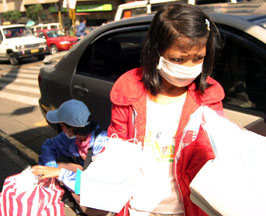Meningo
Scare and the Dying Public Health System
A
Baguio-based health group scores how the government handled the meningo
panic that gripped the city, saying there is even more to fear from the
ineffectual Philippine health care system.
By Community Health Education, Services and Training in the Cordillera
Region (Chestcore)
Posted by Bulatlat
 |
Girl walks around Baguio
with nose covered,
in fear of meningococcemia
Photo by Ace Alegre |
BAGUIO CITY - The
Department of Health’s (DoH) declaration that Baguio
City is “meningococcemia free” will
surely elicit a sigh of relief from many people. But this is no time to
relax or to feel secure for the present meningococcemia scare is but a
reflection of the moribund state of the Philippines’ public health care
system. As we have been proven vulnerable in recent months to panic,
misinformation and lack of decisive government action that fed the meningo-panic,
so too do we remain under threat from all sorts of infectious diseases and
chronic illnesses.
The meningo-panic was
fed by a basic lack of definite and widespread information dissemination
on meningococcemia. People were speculating that the disease could be
spread by merely being in the vicinity of hospitals or the public market.
Even government-initiated campaigns such as the clean-up drives, although
a sound public health measure by itself, did not directly stop the spread
of meningococcemia and in fact, served to reinforce the misinformation
that the disease came from dirty surroundings.
Money and resources
were spent on high-profile campaigns that did not necessarily target the
roots of the outbreak and the consequent panic. This is similar to the
National Immunization Day or Libreng Patak (free immunization)
campaigns of the DoH which emphasize single-event immunizations rather
than striving to provide enough budget to expand the EPI (ironically
called the ‘Expanded’ Program of Immunization). This is also the way
malnutrition is addressed in this country -- by launching a Micronutrient
Program which emphasizes certain vitamins and minerals or fortifying
certain junk foods, because there is not enough money for feeding programs
or for subsidizing farmers.
Because of this
budget anemia, immunization for the groups at highest risk of contracting
meningococcemia was never a consideration. Although experts explained that
World Health Organization (WHO) guidelines did not advise mass
immunization at this time, one cannot help but surmise that cost must have
been a primary consideration as well.
Insufficient
When government funds
and public health services are insufficient, private interests step in.
Private enterprise, from peddlers hawking masks at every street corner
along Session Road to rumors of private physicians cornering the supply of
vaccines and inflating its true price, thrives in a free market. A
judicious policy to take at this time would have been to assume strict
government control over the supply, distribution and price of vaccines.
But this was not done either as liberalization or “free-market economics”
prevails even in a vital service sector as health.
Meanwhile,
meningococcemia continues to plague the poor – the urban poor of San
Carlos, the market vendors of Hilltop, etc. For after all, the poor are
always the worst victims of a moribund public health care system. They
have the least means available to cope with this disaster – they cannot
afford their own immunizations, stand to lose the breadwinners of their
families, and are most vulnerable to the economic repercussions from
decreased sales. Alas, even with regards meningococcemia, the poor can
only get poorer.
While the poor have
the most to lose from this disaster, all of us actually have much to fear.
There is much to fear when our government allots a mere 30 centavos per
Filipino per day for our health care.
There is much to fear
when the major portion of our national budget goes to paying off foreign
debts (up to 40 percent of the budget at times) and funding military
spending (15-20 percent).
There is much to fear
when profit continues to dictate the supply and distribution of vital
medicines and vaccines.
There is indeed much
to fear from a moribund health care system that cannot deal decisively
with meningococcemia.
Community Health Education,
Services and Training in the Cordillera Region (Chestcore) is a Baguio-based
health institution
BACK TO TOP ■
PRINTER-FRIENDLY VERSION ■
COMMENT
© 2004 Bulatlat
■ Alipato Publications Permission is granted to reprint or redistribute this article, provided its author/s and Bulatlat are properly credited and notified. |